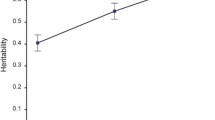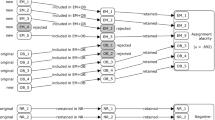Abstract
Heritability coefficients are offered for four personality source traits, measured by the O-A (objective-analytic) 2-h performance battery. Five family constellations covering a total sample of 1221 boys 12–18 years old yielded nine concrete variances which the MAVA (multiple abstract variance analysis) model resolves into seven abstract variances: σ2 wg , within family genetic; σ2 wt.s , within family threptic; σ2 wt.t , within family threptic for twins; σ2 bg , between family genetic; Г bgbt , correlation of genetic and threptic deviations across families, etc. Maximum likelihood was the method here used for the MAVA analysis. The best fit with maximum parsimony was to assume no genothreptic (Г wgwt ,Г bgbt ) correlations, but extension to the parsimony of assuming either no genetic or no threptic components gave no fit. The heritabilities found were compared with those from an earlier research and from a different (OSES) method applied to the present data. The agreement is quite good in assigning a moderate heritability value tocapacity to mobilize vs. regression, U.I.23 (H about 0.30), and toanxiety, U.I.24 (H about 0.50); only moderately consistent in assigning a moderateH value toasthenia, U.I.28 (H about 0.30); and poorly consistent in assigning a lowH value tonarcistic ego, U.I.26. It is pointed out (a) that the lowH for U.I.28 fits the theory of the origin of this trait well and (b) that, in view of estimates of the function fluctuation of U.I.23 and 24, a most probable conclusion is that a capacity to mobilize is quitesubstantially innate and a general proneness to anxiety islargely innate.
Similar content being viewed by others
References
Canter, S. (1969). Personality traits in twins, unpublished paper. British Psychological Society Annual Conference.
Cattell, R. B. (1953). Research designs in psychological genetics with special reference to the multiple variance method.Am. J. Hum. Genet. 7:76–93.
Cattell, R. B. (1960). The multiple abstract variance analysis equations and solutions: For nature-nurture research on continuous variables.Psychol. Rev. 67:353–372.
Cattell, R. B. (1963). The interaction of hereditary and environmental influences.Br. J. Stat. Psychol. 16:191–210.
Cattell, R. B. (1964). The parental early repressiveness hypothesis for the authoritarian personality factor, U.I.28.J. Genet. Psychol. 106:333–349.
Cattell, R. B. (1965). Methodological and conceptual advances in evaluating hereditary and environmental influences and their interaction. In Vandenberg, S. G. (ed.),Methods and Goals in Human Behavior Genetics, Academic Press, New York, pp. 95–104.
Catell, R. B. (1973a). Unravelling maturational and learning developments by the comparative MAVA and structured learning approaches. In Nesselroade, J. R., and Reese, J. (eds.),Life Span Developmental Psychology, Academic Press, New York, pp. 111–114.
Cattell, R. B. (1973b).Personality and Mood by Questionnaire, Jossey Bass, San Francisco.
Cattell, R. B. (1978). Adolescent age trends in primary personality factors measured in T-data: A contribution to use of standarized measures in practice.J. Adoles. 1:1–16.
Cattell, R. B. (1979).Personality and Learning Theory, Springer, New York.
Cattell, R. B. (1982).The Inheritance of Personality and Ability: Methods and Findings Academic Press, New York.
Cattell, R. B., and Brennan, J. (1982). State measurement: A check on the fit of the modulation theory model to anxiety and depression states (in press).
Cattell, R. B., and Scheier, J. H. (1961).The Meaning and Measurement of Anxiety and Neurosis, Ronald, New York.
Cattell, R. B., and Schuerger, J. M. (1978).Personality Theory in Action: The Handbook of the Objective-Analytic (O-A) Personality Battery Kit, Inst. Personal. Abil. Test., Champaign, Ill.
Cattell, R. B., and Warburton, F. W. (1967).Objective Personality and Motivation Tests: A Theoretical Introduction and Compendium, University of Illinois Press, Champaign.
Cattell, R. B., Blewett, D. B., and Beloff, J. R. (1955). The inheritance of personality. A multiple variance analysis determination of approximate nature-nurture ratios for primary personality factors in Q-data.Am. J. Hum. Genet. 7:122–146.
Cattell, R. B., Stice, G. F., and Kristy, N. (1957). A first approximation to nature-nurture ratios for eleven primary personality factors in objective tests.J. Abnorm. Soc. Psychol. 54:143–159.
Cattell, R. B., Rickels, K., Wiese, O., Gray, B., Mallin, Y., Yee, R., and Aaronson, H. (1966). The effects of psychotherapy on measured anxiety and regression.Am. J. Psychother. 20:261–269.
Cattell, R. B., Schmidt, L. R., and Pawlik, K. (1973). Cross-cultural comparison (U.S.A., Japan, Australia) of the personality factor structure of 10 and 14 year olds in objective tests.Social Behav. Personal. 1:182–211.
Cattell, R. B., Schuerger, J. M., Ahern, F. M., and Kameoka, V. (1981a). The heritability of fluid and crystallized general intelligence by the MAVA design and OSES analysis.Austral. J. of Psychol. 33:355–374.
Cattell, R. B., Klein, T. W., Schuerger, J. M., and Kameoka, V. (1981b). Application of the MAVA design and the OSES analysis method to determine the heritability of the clinical personality factors: Guilt Proneness, O; Parmia, H; and Ergic Tension, Q4.Personal. Study Group Behav. 1:1–21.
Cattell, R. B., Rao, D. C., Schmidt, L. R. and Vaughan, D. S. (1981c). The heritability of same personality source traits: evidence from MAVA design, maximum likelihood analysis and the O-A battery.L'Année Psychologique 81:429–452.
Eysenck, H. J., and Prell, D. B. (1951). The inheritance of neuroticism: An experimental study.J. Ment. Sci. 97:441–465.
Gulbrandsen, C. L., Morton, N. E., Rao, D. C., Rhoads, G. G., and Kagan, A. (1979). Determinants of plasma uric acid.Hum. Genet. 50:307–312.
Hundleby, J. D., Pawlik, K., and Cattell, R. B. (1965).Personality Factors in Objective Test Devices, Editest, San Diego, Calif.
Ishikawa, A. (1977). Trait description and measurement through discovered structure in objective tests. In Cattell, R. B., and Dreger, R. M. (eds.),Handbook of Modern Personality Theory, Wiley, New York, pp. 104–116.
Jinks, J. L., and Fulker, D. W. (1970). Comparison of the biometrical genetical, MAVA, and classical approaches to the analysis of human behavior.Psychol. Bull. 73:311–349.
Klein, T. W., and Cattell, R. B. (1977). Heritability of personality and ability measures obtained from the HSPQ and the Culture-Fair Intelligence Scales, by the Twin Method.7th Annual Meeting of the Behavior Genetics Society.
Loehlin, J. C. (1965). Some methodological problems in Cattell's multiple abstract variance analysis.Psychol. Rev. 72:156–161.
Loehlin, J. C., and Nichols, R. C. (1976).Heredity, Environment and Personality: A Study of 850 Sets of Twins, University of Texas Press, Austin.
Mittler, P. (1971).The Study of Twins, Penguin Books, London.
Morton, N. E., Gulbrandsen, C. L., Rao, D. C., Rhoads, G. G., and Kagan, A. (1980). Determinants of blood pressure in Japanese-American families.Hum. Genet. (in press).
Rao, D. C., Morton, D. E., Gulbrandsen, C. L., Rhoads, G. G., Kagan, A., and Yee, S. (1979). Cultural and biological determinants of lipoprotein concentrations.Ann. Hum. Genet. 42:467–477.
Schmidt, L. R., Hacker, H. O., and Cattell, R. B. (1975).Objective Test Batteries OA-TB.75. Testheft, Beltz, Weinheim.
Shields, J. (1962).Monogygotic Twins Brought Up Together and Apart, Oxford University Press, New York
Spielberger, C. D. (1972).Anxiety: Current Trends in Theory and Research, Academic Press, New York.
Vandenberg, S. G. (1965).Methods and Goals in Human Behavior Genetics, Academic Press, New York.
Author information
Authors and Affiliations
Rights and permissions
About this article
Cite this article
Cattell, R.B., Vaughan, D.S., Schuerger, J.M. et al. Heritabilities, by the multiple abstract variance analysis (MAVA) model and objective test measures, of personality traits U.I.23, capacity to mobilize, U.I.24, anxiety, U.I.26, narcistic ego and U.I.28, asthenia, by maximum-likelihood methods. Behav Genet 12, 361–378 (1982). https://doi.org/10.1007/BF01065630
Received:
Accepted:
Issue Date:
DOI: https://doi.org/10.1007/BF01065630




